
- Homepage
- Author
- Aleister Crowley (10)
- Anonymous (12)
- C H Spurgeon (10)
- Charles Dickens (25)
- Edgar Allan Poe (14)
- God (22)
- John Dee (21)
- L. Frank Baum (10)
- Lewis Carroll (42)
- Louisa May Alcott (10)
- Maria Parloa (9)
- Mixed Authors (11)
- Multiple (8)
- Rudyard Kipling (28)
- Selected (8)
- Unknow (8)
- Unknown (33)
- Various (41)
- Walter Scott (9)
- William Shakespeare (28)
- ... (5101)
- Binding
- Cloth (54)
- Cloth & Boards (2)
- Disbound (3)
- Fine Binding (206)
- Good (8)
- Hardback (115)
- Hardcover (1147)
- Hardcover / (4)
- Hardcover W / Jacket (3)
- Leather (506)
- Leather / Hardcover (4)
- Manuscript (26)
- Manuscript, Unbound (2)
- Original Copy (99)
- Paperback (7)
- Softcover (3)
- Softcover, Wraps (87)
- Spiral (2)
- Vellum (55)
- Very Good (2)
- ... (3125)
- Language
- Publisher
- Antiquity (47)
- Cassell (7)
- Collector Books (13)
- David Mckay (6)
- Doubleday (9)
- Estes And Lauriat (9)
- Frank Leslie (6)
- Funk & Wagnalls (9)
- Grosset & Dunlap (22)
- Harper & Brothers (14)
- Lille, Blocquel (7)
- Macmillan (15)
- Macmillan And Co. (14)
- Passmore & Alabaster (6)
- Roberts Brothers (6)
- Selected (6)
- The Century Company (10)
- Transylvania Amira (7)
- Unknown (12)
- Various (24)
- ... (5211)
- Topic
- Year Printed
Rare Galluba German Snowed Half Doll Christmas Candy Container Book Example 1910
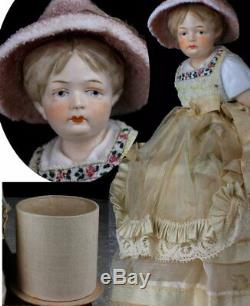
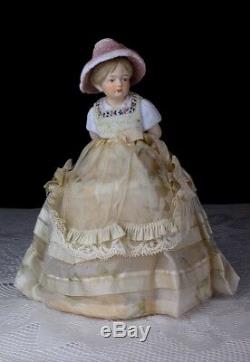
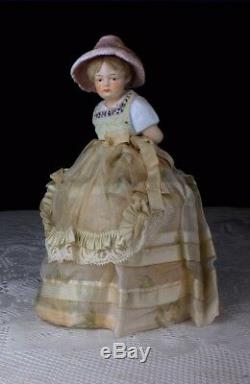
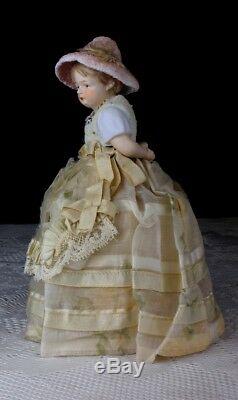
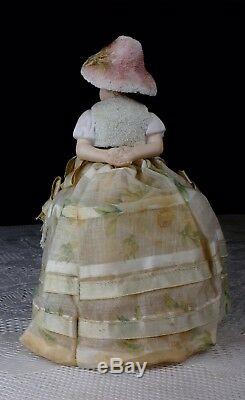
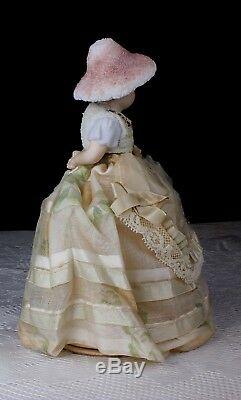
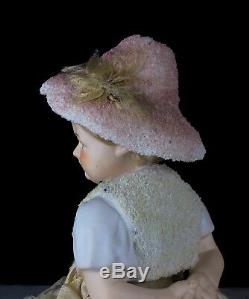
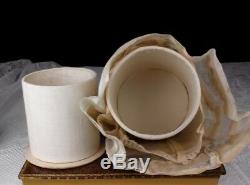
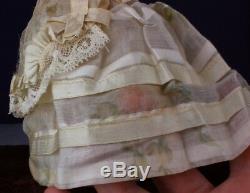
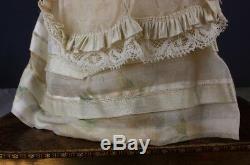
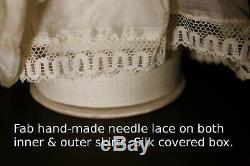
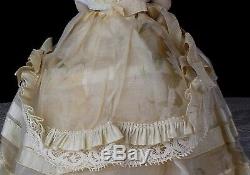


Snowed Half Doll Candy Container. Made in its entirety by the. Galluba & Hofmann Co, Germany C 1910. All original candy container made by the award-winning manufactory Galluba and Hofmann, active in Germany from 1890 to 1926, awarded a gold medal at the 1897 World's Fair in Saxony. Hand-made outfit has 3 layers: Sheer floral outer-skirt with layers of applied ribbon, all hand sewn.
Apron with pleated ribbon and hand-made lace trim. Slip also trimmed with hand-made lace in a different pattern. See the close-up pictures of the beautiful lace. This is all hand-work done by the seamstresses who worked for Galluba, the same talented ladies that crocheted the tiny bathing suits for the Galluba bathing beauties.And the box is silk-covered as well, inside and out a special touch not usually found on candy containers. If you peek up under her bonnet you'll see that her hair is styled in a German braid wrapped around her head. Rare pink snow on bonnet, both inside and out. White snow on blouse, with hand-painted accents. The good news is: just about all of the snow is intact, a testament to how well these early (pre WWI) snow babies were made.
These early snow babies were fired, not cold painted, so the paint doesn't wear. The snow was even glazed and fired separately before application, which is why it tends to stay clean and intact.Some breakage to silk apron, handle with care (last photo, top). Everywhere else, silk is fine. The uneven edges on the hat are how it was made, that is not damage. A couple of tiny dark spots which appear to be misplaced paint in the white snow. Candy container strong and sturdy.
This half doll is in Vol. 1 of the Lorrin Half Doll book; this same Galluba girl is seen in the M.Morrison Snow Baby book, where she is molded together with a boy. Expertly modeled, look at those perfect little hands, with one thumb. No detail was spared on these early pre-war snow babies. How were the early snow babies made? The snow was created by putting big pieces of fired bisque into a large pot-like contraption called a ball mill.
Dense and heavy snowball-sized porcelain balls were added to the mill, then the container was rolled round and round, till the balls crushed the bisque into snow. Timing was important of course to get the right size of snow. I love the big pieces of snow on these old figures (as compared to the post world war II snow babies that have snow which is more like sand). To ensure it would stay clean, the snow was glazed and fired. The snow was then patted into the wet clay model, making sure it was liberally applied, and then it was glazed once again and fired on.A very labor intensive process, a labor of love, really. I have other snow babies on offer, an equally rare pair - they're. Listed in the Morrison snow baby book as extremely rare. Daylight bulbs used for accurate color but monitor colors may vary. I pack very safely to ensure you get your item safely.
In the unlikely event there is loss or damage in transit. I've taken great care with description and have provided many large clear photos. Photos are part of the description. By purchasing from me you agree to these terms. To contact me for any reason after the sale please use.
I value my customers and always do my best to ensure you have a pleasant shopping experience; thank you for your patronage. The item "Rare Galluba German Snowed Half Doll Christmas Candy Container Book Example 1910" is in sale since Thursday, January 31, 2019. This item is in the category "Antiques\Decorative Arts\Ceramics & Porcelain\Figurines". The seller is "sussexcountyantiques" and is located in Stanhope, New Jersey.
This item can be shipped worldwide.- Primary Material: Ceramic & Porcelain
- Featured Refinements: Antique Half Doll
- Age: 1910
- Maker: Galluba Hofmann
- Original/Reproduction: Original
- Color: Pink
- Country/Region of Origin: Germany
- snow baby: antique christmas ornament

